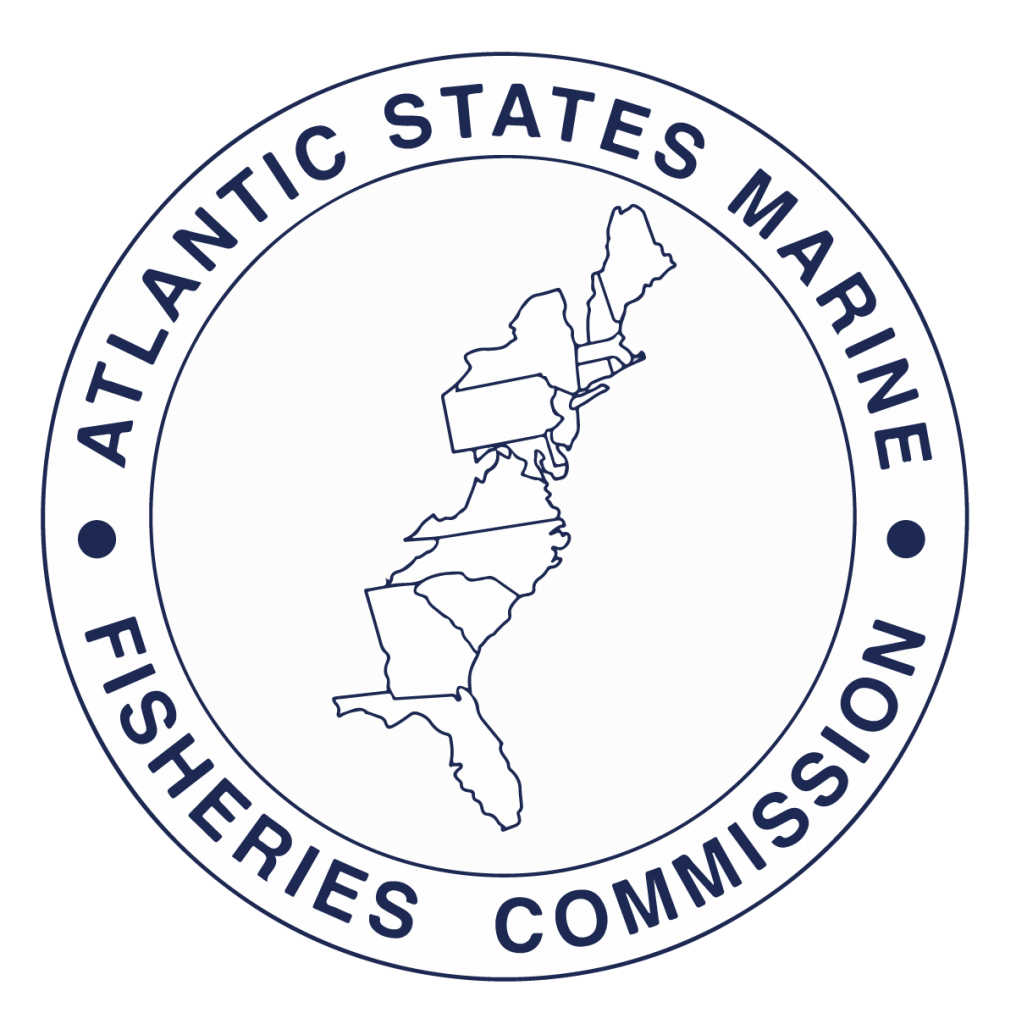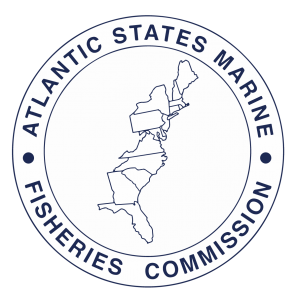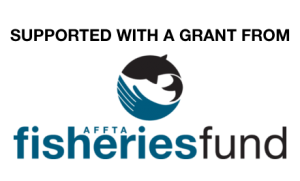ASMFC 2024 Spring Meeting (Wednesday May 1, 2024 1:15-2:45pm EST)
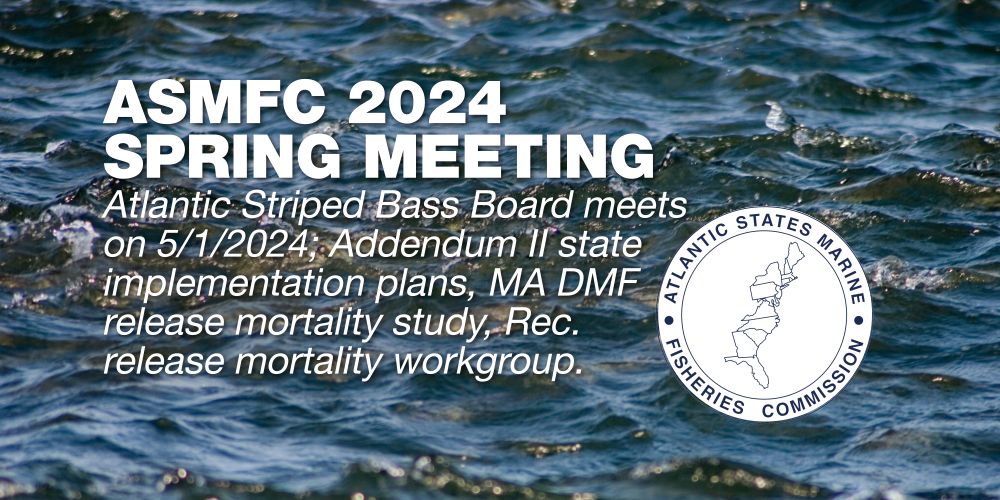
Tomorrow, Wednesday May 1, 2024 from 1:15pm to 2:45pm EST the ASMFC Atlantic Striped Bass Management Board will meet to discuss a variety of items and possibly take action on several. Below is the meeting agenda.
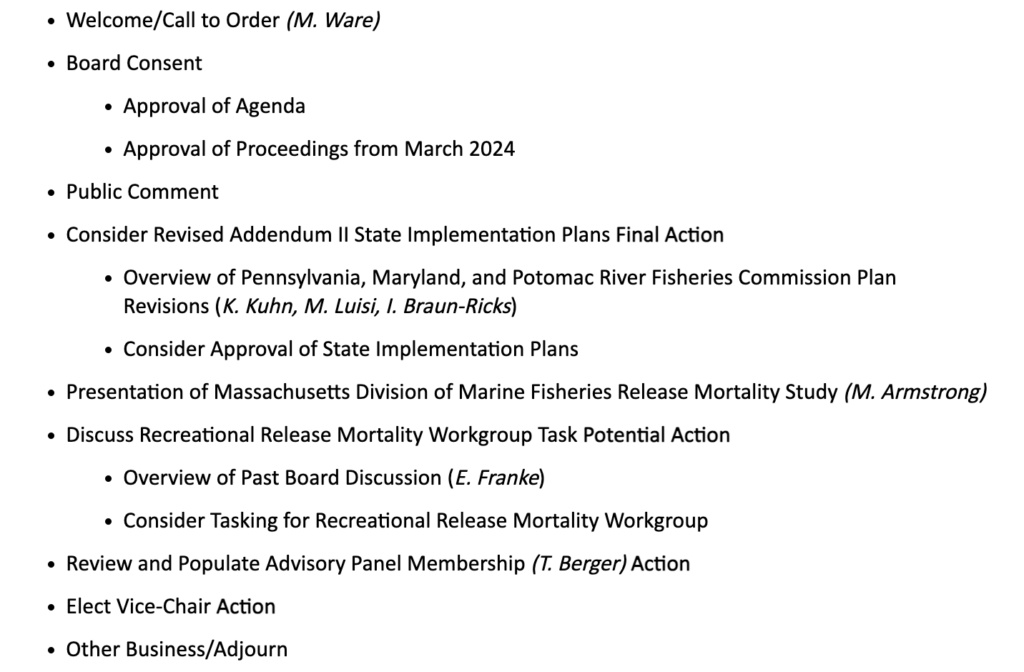
Of particular interest, the revised implementation plans from Pennsylvania, Maryland and Potomac River Fisheries. During the boards last meeting in March, Mike Luisi of Maryland made every imaginable attempt to avoid compliance. In fact, the meeting ended with Mr. Luisi asking for information on how non-compliance would unfold. This certainly felt like a clear indication of Maryland’s intentions, the rest of the board was not in favor and requested revised implementation plans. The board will consider final approval of state implementation plans for Addendum II measures.
We also look forward to the presentation by Michael Armstrong (MA) on the Division of Marine Fisheries release mortality study. An update to the last , and now outdated release mortality study, has been long overdue. Considering how large of an impact the recreational sector has on the stock, a precise estimate of release mortality is very important to future management. Following the presentation the board will discuss and likely form a workgroup (smaller group of board members) to take closer and more prolonged look at release mortality. We hope that a conservation minded group of board members is formed to do so.
As always, we will be in attendance and will provide a meeting summary as quickly as possible. If you would like to attend please use the webinar link below.
To register for the live webinar please click here: ASMFC 2024 Spring Meeting – Atlantic Striped Bass Management Board
You can also attend via phone: Webinar ID: 385-329-571 Phone: 415.655.0060 Access Code: 439-781-011
ADDITIONAL LINKS
- ASMFC Spring Meeting: Main Meeting Materials (PDF)
- ASMFC Spring Meeting: Supplemental Meeting Materials (PDF)
ASMFC 2024 Winter Meeting Summary – Conservation (Mostly) Wins
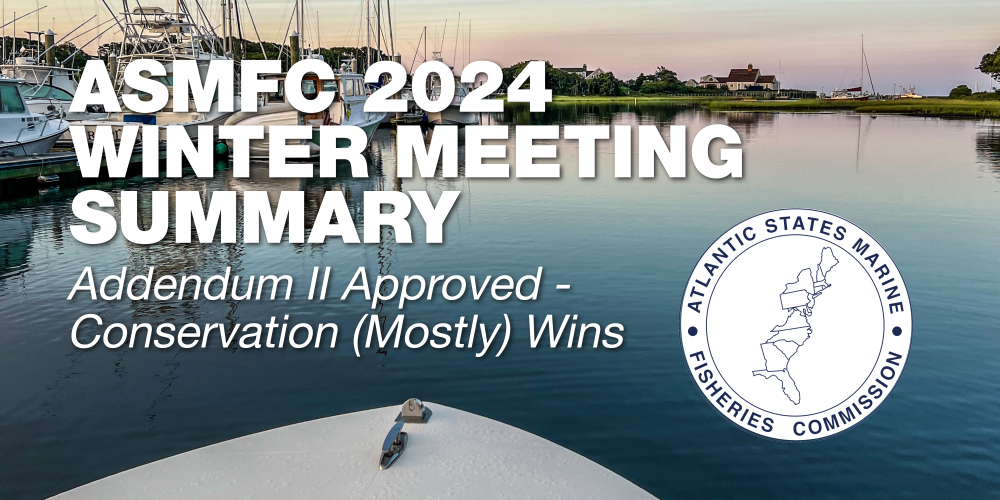
A quick note before we get started with a summary. As we have done in the past, we provided live updates from the meeting through our Instagram account (@stripersforever) stories. If you are unable to attend a meeting it is a great way to stay up to date both during and after the meeting. Instagram is a great tool for connecting us with our supporters, we encourage everyone to give us a follow and to tune into our stories during future ASMFC meetings.
Last Wednesday, January 24, 2024, the Atlantic Striped Bass Management Board met during the ASMFC 2024 Winter Meeting. The final version of Addendum II to Amendment 7 was approved by the board. Conservation (mostly) won, more on the mostly part later. There was a lot on the table with implications to rebuilding of the stock and beyond. For the beyond, there were some options within Addendum II which had the potential to drastically change policy and the future management of Striped Bass. ‘Mode splits’, the elephant in the room, a proposed separation of private and for-hire anglers. Essentially this would have set different regulations for each party, where for-hire patrons would be allowed a wider slot and/or the right to keep more fish. The good news is that none of the options containing mode splits passed, the greater majority of the board realized that it was not the right thing to do and certainly not the right time to make such a drastic policy change. This was a big win for conservation. As Dennis Abbott of New Hampshire stated, “I’m opposed to this motion, I’m opposed to it for a number of reasons. And one of them is that I see a basic unfairness. There are millions of people who fish for Striped Bass and there are a small minority in the for-hire sector. I don’t see how we should advantage one group over the other.” Mr. Abbott went on to give what he termed a ‘sermon’, an inspiring reflection on 28 years of sitting on the Striped Bass board. His words were powerful as he urged the board to “do the right thing for the resource”. It set the stage for the remainder of the meeting, we commend and thank him for such an impactful ‘sermon’.
As you can see for yourself in the Supplemental Materials supplied before the meeting, public comment overwhelmingly supported the most conservation minded options available. It was no surprise that the usual suspects (mainly MD & NJ) would diverge and push for the complete opposite, the shortsightedness of some is astounding. Thankfully their selfish attempts to lead the board down a dark path fell on deaf ears as motion after motion failed and conservation (mostly) won. As you can see below, almost every option we supported passed and for 2024 Addendum II will essentially extend the emergency action ocean recreational fishery regulation of 1-fish at 28-31″ for all modes. So what does conservation (mostly) won refer to? After pleading with the board and multiple attempts at other options to “save the commercial fishery”, the board elected to pass a 7% quota reduction from the ocean and Chesapeake Bay commercial fisheries. In the face of 5 years of poor recruitment in the Chesapeake and now a failed 2023 spawn in the Hudson River, we really hoped the board would elect to maximize the commercial quota reduction at 14.5%. This was not a win for conservation but it was also not a total loss, as the saying goes, the devil is in the detail. Having failed to secure a less conservation minded Chesapeake Bay recreational option, the devilish powers at be shifted focus to delaying the compliance schedule for a variety of reasons that other board members saw through like the clear waters of a flat at high sun. An attempt to delay commercial compliance until 2025 failed and in its place a motion passed in which states must implement regulations (both recreational and commercial) by May 1, 2024. Another big win for conservation.
Below is a breakdown of each final motion as passed by the board. The bullet points that follow summarize our reactions along with some points derived from questions we have been asked following the meeting. Also below, links to; ASMFC press release, presentation slides, meeting recording and the 2024 Winter Meeting Summary.
3.1.1 Ocean Recreational Options – Move to approve in Section 3.1.1. Ocean Recreational Fishery Option B: 1-fish at 28-31″ with 2022 seasons for all modes. Motion passes 14-2-0-0.
- After much discussion and a failed attempt at Option C (mode splits), the board voted to pass Option B, our preferred option. This option secures the greatest overall reduction, protection for the 2015-year class as they mature and does so in a fair and equitable way across all sectors. A great win for conservation in 2024.
3.1.2 Chesapeake Bay Recreational Options – Move to approve in Section 3.1.2. Chesapeake Bay Recreational Fishery Option B2: 19-24″ slot, 1-fish for all modes, 2022 seasons. Motion passes 14-2-0-0.
- Maryland tried relentlessly to convince the board to go against the will of the people. After three failed attempts, we can thankfully say, they were smarter than that. Again we avoided an option with mode splits. And while the slot gained an inch over the prefered Option B1 (19-23″), we have to consider this a win as things could have gone much worse. In typical fashion, only MD and NJ were in opposition to the final motion. Option B2 creates more uniform regulations across the bay and similarly to Option B1 is estimated to meet the 14.5% overall reduction. Given the circumstances we will put this in the win column.
3.1.3 For-Hire Management Clarification
- Because no options containing mode splits were selected by the board this section did not require any action.
3.1.4 Recreational Filleting Allowance Requirements – Move to approve in Section 3.1.4 Recreational Filleting Allowance Requirements Option B: For states that authorize at-sea/shore-side filleting of striped bass, establish minimum requirements, including requirements for racks to be retained and possession to be limited to no more than two fillets per legal fish. Motion passes 15-0-0-2.
- This was a fairly easy topic of discussion and with only a slight adjustment the board passed Option B. This is very simple, in the event that a conservation officer boards a vessel or checks on a shore angler, it would be possible for that officer to know whether or not the fish was legally harvested. We are adding to the toolkit law enforcement has to ensure compliance by the anglers, again we were happy to see this pass.
3.2.1 Commercial Quota Options – Move to approve in Section 3.2.1 Commercial Quota Reduction Option B: 7% reduction from Ocean and Chesapeake Bay 2022 quotas with 2022 size limits.
- This was the one section where we had hoped to see a larger reduction of 14.5%. But there are a couple of important points to consider here. Some of the following points answer questions we heard following the meeting on January 24th.
- There were only two options for the board to choose from; Option A- Status Quo and Option B- A reduction from zero to 14.5%. After the motion for status quo failed the board had to decide on the actual percent reduction.
- We hoped they would max it out but that was not in the cards. Keep in mind, this is a reduction in quota, not harvest. The reality is that some states would not have seen any reduction at all, whether it was 7% or 14.5%. This is, in our opinion, a failure of the Addendum but a reality of the language within it.
- NJ will need to factor this reduction in when converting their commercial quota to the recreational bonus tag program.
- Thankfully, due to the agreed upon compliance schedule (below) we will actually see this reduction take effect in 2024. Prior to this meeting that was very much up in the air.
- It is likely that Addendum II measures will only be in effect for the 2024 season. As noted below in section 3.3, the board will be able to quickly react to the next stock assessment in the fall of 2024. Given the failed recruitment (spawning) in both the Chesapeake Bay and Hudson River, we are preparing for some bad news in that next assessment. If that is how things turn out, the board will likely take much stronger action to ensure we stay on track to recover the stock by 2029. That means we will be back at the drawing board to implement new measures for the 2025 fishing season.
3.3 Stock Assessment Response Options – Move to approve in Section 3.3 Response to Stock Assessments Option B: Board could respond via Board action to change management measures by voting to pass a motion at a Board meeting. Motion made by Dr. Davis, second by Mr. Borden. Passes 11-5-0-0.
- As we mentioned above, there is a really good chance that Addendum II will only be in effect for a one year period. The next stock assessment results are expected in the fall of 2024. Given the 5 years of very poor recruitment in the Chesapeake Bay and a failed spawn in the Hudson River in 2023, there is a good chance that stronger management changes will be needed to ensure a greater than 50% chance of rebuilding by 2029. If the board is required to do so via another Addendum, that process could take close to a year to finalize. The Striped Bass stock does not have that kind of time right now. Option B would allow the board to react by voting by a simple majority. While we prefer to have a public comment period, it just becomes a cumbersome and time consuming process which puts us farther behind in terms of rebuilding. This is unfortunate, the writing has been on the wall for years and as you are probably already aware, Stripers Forever has been calling for the most conservative measures since the beginning of the Amendment 7 process. If the results of the next stock assessment are as bad as we anticipate, the conversation about a equitable harvest moratorium will most certainly be back on the table.
Compliance Schedule – Move to approve the following compliance schedule: States must submit implementation plans by March 1, 2024. The Board will review and consider approving implementation plans in March 2024. States must implement regulations by May 1, 2024. Motion by Dr. Armstrong, second by Mr Borden. Motion passes 10-4-0-2.
- There was a lot of uncertainty around the implementation schedule. We heard in previous meetings that some states would not be able to implement commercial regulations for the 2024 season. The reasoning was suspicious and centered largely around the inability to generate the physical tags that were needed. Having already passed only a 7% commercial reduction, delaying until 2025 would have effectively cut that in half yet again. Thankfully the majority of the board saw through this and after a failed motion to delay until 2025, a motion passed in which all states would be required to implement regulations no later than May 1, 2024. This was a really big win!
From the ASMFC:
ASMFC Atlantic Striped Bass Board Approves Addendum II – Establishes Measures to Continue Progress Towards Stock Rebuilding
Arlington, VA – The Commission’s Atlantic Striped Bass Management Board approved Addendum II to Amendment 7 to the Interstate Fishery Management Plan (FMP) for Atlantic Striped Bass. The Addendum modifies recreational and commercial measures to reduce fishing mortality in 2024, establishes an expedited response process to upcoming stock assessments, and addresses requirements for recreational filleting. Addendum II builds upon the 2023 emergency action by changing the measures in the FMP to reduce fishing mortality and support stock rebuilding. Addendum II measures will replace the emergency action measures upon its implementation by the states by May 1, 2024.
“First and foremost, thank you to the 2,000 members of the public who submitted public comments. The Board had difficult issues to discuss, and public comments were a crucial part of the deliberations,” said Board Chair Megan Ware from Maine. “The Board remains focused on rebuilding the stock by 2029. The upcoming 2024 stock assessment will be an important checkpoint on progress toward rebuilding.”
For the ocean recreational fishery, the Addendum implements a 28” to 31” slot limit, 1-fish bag limit, and maintains 2022 season dates for all fishery participants; this maintains the same ocean recreational measures adopted under the recent emergency action. For the Chesapeake Bay recreational fishery, the Addendum implements a 19” to 24” slot limit, 1-fish bag limit, and maintains 2022 season dates for all fishery participants. For the commercial fishery, the Addendum reduces commercial quotas by 7% in both the ocean and Chesapeake Bay.
To address concerns about recreational filleting allowances and compliance with recreational size limits, the Addendum establishes two requirements for states that authorize at-sea/shore-side filleting of striped bass: racks must be retained and possession limited to no more than two fillets per legal fish.
To enable an expedited management response to upcoming stock assessments prior to the 2029 rebuilding deadline, the Addendum establishes a mechanism allowing the Board to respond to a stock assessment via Board action if the stock is not projected to rebuild by 2029.
States must submit implementation plans by March 1, 2024 for Board review and approval, which will take place at a special Board meeting to be scheduled for later in March. All Addendum II measures must be implemented by May 1, 2024.
The press release can also be found at: https://asmfc.org/files/2024WinterMeeting/2024WinterMeetingSummary_revised.pdf
For more information, please contact Emilie Franke, Fishery Management Plan Coordinator, at efranke@asmfc.org or 703.842.0740.
ADDITIONAL LINKS
- Atlantic Striped Bass Board 2024 Winter Meeting: Presentations (PDF)
- Atlantic Striped Bass Board 2024 Winter Meeting: Meeting Recording Audio/Video (YouTube)
- ASMFC 2024 Winter Meeting Summary: 2024 Winter Meeting Summary (PDF)
ASMFC 2024 Winter Meeting (1/24/24) & Hudson River 2023 YOY Report
ASMFC 2024 Winter Meeting of the Atlantic Striped Bass Management Board
To register for the live webinar please go here: ASMFC 2024 Winter Meeting- Striped Bass Management Board (GoToMeeting Webinar ID: 795-025-635)
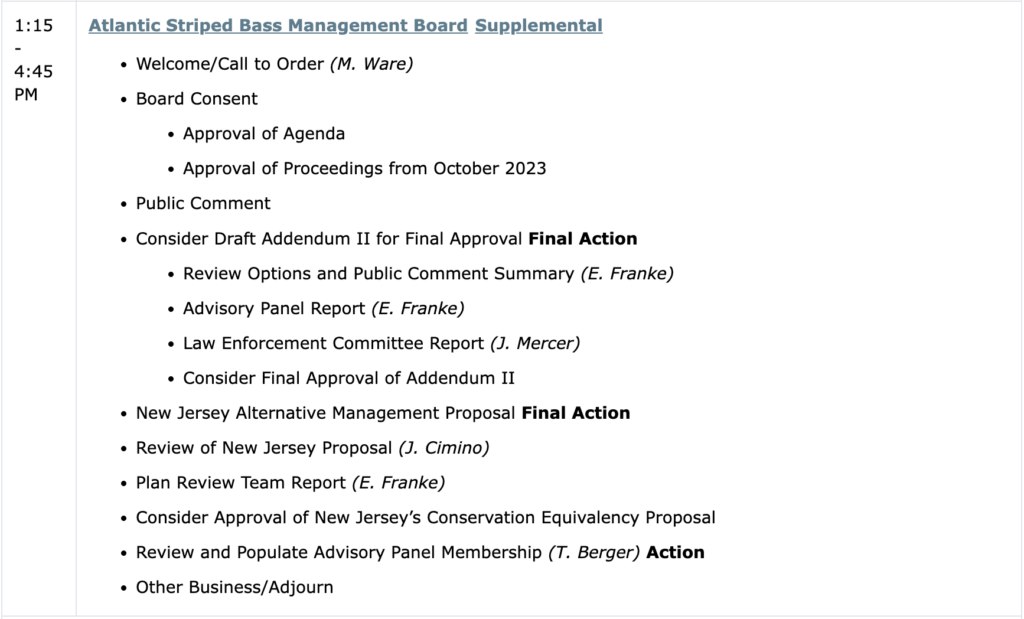
ADDITIONAL LINKS
- Atlantic Striped Bass Board- Draft Agenda/ Meeting Overview/ Main Meeting Materials
- Atlantic Striped Bass Board- Supplemental Materials
Hudson River, NY 2023 YOY (young-of-year) Survey Results
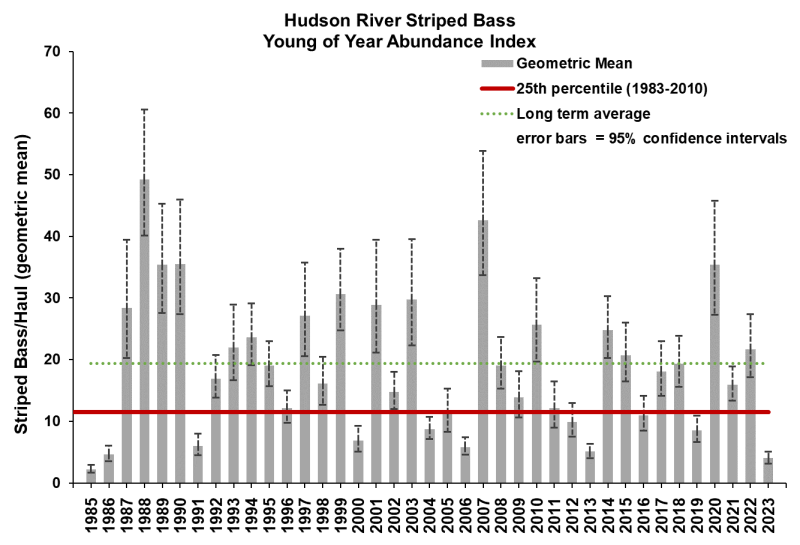
The NYDEC Hudson River 2023 young-of-year survey results are in and we are sad to report another failed spawn. See the above graph and notice the big drop from 2022 to 2023. Many factors can affect spawning success, environmental conditions being one of them. Perhaps the warmer than usual winter with low snowpack is part of the problem. Maybe fishing shouldn’t be allowed when and where the fish are spawning, we have supported the introduction of seasonal closures since the beginning of the Amendment 7 process. Either way, this 2023 result only rubs salt in the wound, the Striped Bass stock is in big trouble.
ACTION ALERT- ASMFC Addendum II To Amendment 7
ACTION ALERT
Public comment will be accepted until 11:59 PM (EST) on December 22, 2023
ASMFC Addendum II to Amendment 7 to the Interstate Fishery Management Plan for Atlantic Striped Bass
The hope was for Addendum II to go above and beyond the emergency action currently in place. The likely reality is, even with the best options selected by the board, Addendum II will ultimately fail to do enough to get the stock back on track for recovery by 2029. In the face of 5 straight years of very poor, bordering on failed recruitment in the Chesapeake, the board has put forth options which would fail to protect the 2015 year class. In fact, some of the options within Addendum II work directly against the intentions of the original motion from which it was born.
To be honest, we still believe that an equitable (commercial and recreational) harvest moratorium is the most efficient and full proof way to rebuild the Striped Bass stock to abundance. Unfortunately that is not currently an option within Addendum II. While you may feel the same way and want to express that to the board, it is very important that we stay within the bounds of what is currently in the document. Feel free to add your thoughts in your own words but please make sure to clearly state that you support the options below. The stock is still in a bad place and there is very little margin for error. We absolutely need to make sure that the best possible options within Addendum II are selected by the board.
Below you will find our preferences for each of the six sections of options. The bullet points below briefly explain our rationale behind each choice. You can keep things simple and just comment to the board which options you support. You can also add your own reasoning and/or suggestions. The bottom line is, we all need to be part of the process to make our voice heard. The more who speak up in favor of the below options, the better chance we have for a positive outcome.
It is important to note, if you are unable to participate in your state’s scheduled hearing, you are welcome to participate in any of the virtual or hybrid hearings. Click here for the news release on all state public hearings.
The in person hearings are one way to participate but we strongly suggest that you submit written comments to the board. Instructions on how to do so are below.
Thank you for your involvement and continued support!
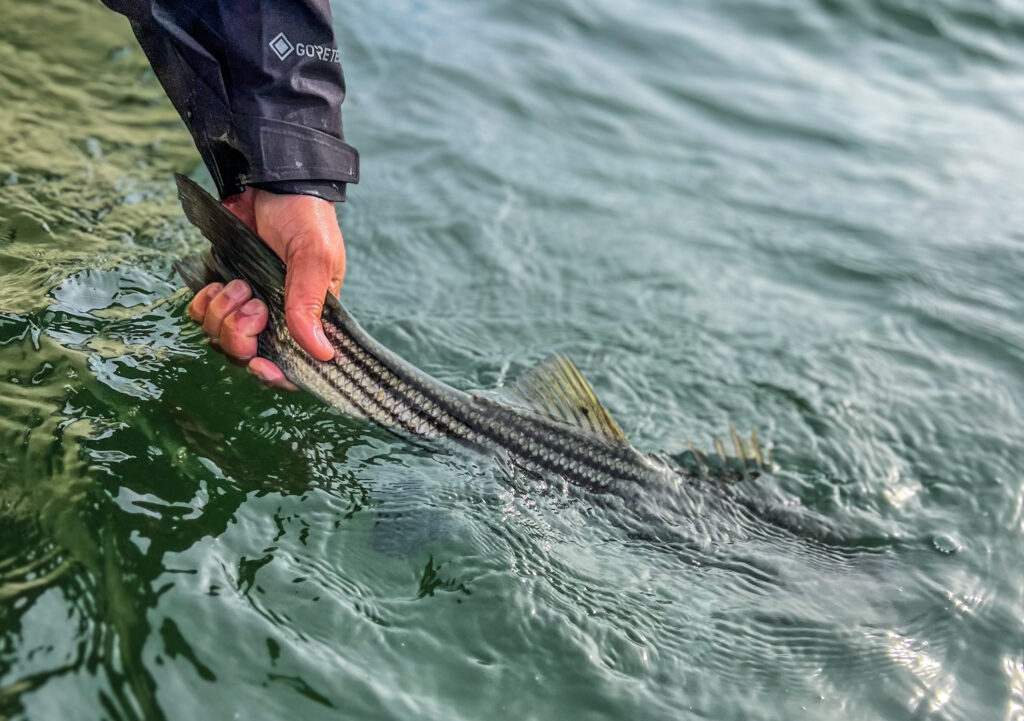
3.1.1 Ocean Recreational Fishery Options: Support Option B—1-fish at 28 to 31″ with 2022 seasons (all modes).
- There are three goals here; the greatest overall reduction, protecting the 2015-year class and making sure it is done in a fair and equitable way. Option A expands the slot to 28″-35″, Option C and D introduce ‘mode splits’. Essentially, recreational anglers are split into ‘private vessel/shore’ and ‘for-hire’, it is not the right thing to do now or ever. Since the inception of Amendment 7, we have heard from the board and law enforcement that no harvest and no target closures would be too difficult to enforce, the same applies here. All recreational anglers should make an equitable effort to reduce harvest and restore the Striped Bass stock to abundance. Option D shifts the slot up in size and would only do more damage to the 2015-year class as they continue to grow and enter that range.
3.1.2 Chesapeake Bay Recreational Fishery Options: Support Option B1—Apply a standard minimum size limit, maximum size limit, and bag limit to the Bay jurisdictions’ 2022 seasons. The minimum size shall be 19” and the bag limit 1 fish. Maximum size limit of 23”.
- Here we selected Option B1 for several reasons. Most importantly it produces the greatest overall reduction of -22.4% and the greatest harvest reduction of -38.4%. After 5 years of very poor spawns in the Chesapeake Bay, it is time for some simplification and a narrow slot. Option B1, with consistent minimum size, maximum size, and bag limit creates more uniform regulations across the bay. Again, as previously discussed in the ocean recreational options, mode splits are not something we can support in anyway.
3.1.3 For-Hire Management Clarification (if For-Hire Mode-Specific Limits are selected): Support Option B—For-hire management measures apply only to patrons during a for-hire trip; captain and crew during a for-hire trip are subject to the private vessel/shore angler limits.
- We do not support mode splits in anyway, as discussed in the first two sections. Should the board choose to adopt (most likely against public comment) mode splits we should do what we can to minimize the potential damage. Option B only allows the additional harvest to apply to the patrons during a for-hire trip. The captain and crew are subject to the same regulations as private vessel/shore anglers.
3.1.4 Recreational Filleting Allowance Requirements: Support Option B—For states that authorize at-sea/shore-side filleting of striped bass, establish minimum requirements, including requirements for: racks to be retained; skin to be left intact; and possession to be limited to no more than two fillets per legal fish. States should consider including language about when and where racks may be disposed of, specific to each mode allowed to fillet at-sea/shore.
- This is no time to be lax about regulations and keeping anglers honest. If we want to get the stock back on track for recovery then we should do all that we can to make sure fish are legally harvested and within the slot limit. Option B requires that, in states where at-sea/ shore-side filleting is allowed, anglers must retain the rack (what is left of the fish after cutting off fillets) and keep the skin on the fillets. This is very simple, in the event that a conservation officer boards a vessel or checks on a shore angler, it would be possible for that officer to know whether or not the fish was legally harvested. We are adding to the toolkit law enforcement has to ensure compliance by the anglers.
3.2.1 Commercial Quota Reduction Options: Support Option B—The ocean commercial fisheries and/or Chesapeake Bay commercial fisheries will be managed by quotas representing up to a 14.5% reduction from their 2022 quotas with their 2022 size limits. The Board will select the specific percent reduction between zero and 14.5%.
- Status quo is just not an option at this point. As stated, “Status quo has a reduced probability to achieve the objective of this addendum.” An equitable reduction in harvest gives us the best possible chance at getting the rebuild back on track. While it is unfortunate that the board will ultimately get to choose the percent reduction, the bottom line is Option B will reduce commercial harvest beyond the 18% reduction put in place by Amendment 7. In your comments please suggest that the board select the largest possible reduction of 14.5%.
- We should note that there are several concerning matters surrounding a commercial quota reduction.
- First off, it is important to understand that the reduction is to the allowable total harvest number, not to the actual harvest. So, states that do not max out their quota may not see any actual reduction in mortality. Let’s say a state only harvests 80% of its total allowable quota. In that case a 14.5% reduction in quota would not save a single fish. For example, in the past we have reported on Massachusetts struggling to fill its commercial quota. To us its a clear sign that there are just not enough fish around but the troubling part is that if history repeats itself, than this best case scenario of a 14.5% reduction could mean no actual change in commercial harvest. As we have always said, to rebuild this stock we need equitable reductions in mortality. We all need to give something to get something in return.
- Secondly, there was much discussion between board members regarding their ability (or inability) to getting these new commercial regulations in place for the 2024 season. The main reason seemed to stem from the timing of this Addendum II process. Public comments would be taken through December and then final board action would be taken in January. Several board members said it would be very difficult or flat out impossible for them to change commercial regulations at that point. It seemed to hinge on the production of the physical tags but in reality it really just seemed like they were reaching for an excuse to not get the job done. While this mainly pertains to more southern states where the commercial season begins earlier, it would be a complete farce if Addendum II reductions are only applied to the recreational sector.
3.3 Response to Stock Assessment: Support Option B—The Board could respond via Board action where the Board could change management measures by voting to pass a motion at a Board meeting instead of developing an addendum or amendment and different from the emergency action process.
- As we mentioned in our summary of this past ASMFC board meeting, there is a really good chance that Addendum II will only be in effect for a one year period. The next stock assessment results are expected in the fall of 2024. Given the 5 years of very poor recruitment in the Chesapeake, there is a good chance that stronger management changes will be need to ensure a greater than 50% chance of rebuilding by 2029. If the board is required to do so via another Addendum, that process could take close to a year to finalize. The Striped Bass stock does not have that kind of time right now. Option B would allow the board to react by voting by a simple majority. While we prefer to have a public comment period, it just becomes a cumbersome and time consuming process which puts us farther behind in terms of rebuilding. This is unfortunate, the writing has been on the wall for years and as you are probably already aware, Stripers Forever has been calling for the most conservative measures since the beginning of the Amendment 7 process. If the results of the next stock assessment are as bad as we anticipate, the conversation about a equitable harvest moratorium will most certainly be back on the table.
Submit Your Comment
All those interested in the management of Atlantic striped bass are encouraged to provide input either by participating in public hearings, which may be conducted via webinar, or providing written comment. If you are unable to participate in your state’s scheduled hearing, you are welcome to participate in any of the virtual or hybrid hearings.
Submit Comment: Draft Addendum II to Amendment 7
Email: comments@asmfc.org
Subject Line: Striped Bass Draft Addendum II
Emilie Franke
FMP Coordinator
1050 N. Highland Street
Suite 200 A-N
Arlington, Virginia 22201
Public comment will be accepted until 11:59 PM (EST) on December 22, 2023
Public Hearing Schedule
Below you will find all important information and links for each of the state hearings. Here is the official ASMFC news release on all state public hearings, it also contains contact info for each state/agency.
Please note: This schedule has been revised since its initial release and includes a change in location for Delaware’s November 28 hearing, the addition of a second hearing for Connecticut on November 30, a change to a hybrid hearing for Rhode Island’s November 30 hearing and the addition of a second hearing for New Jersey on December 5.
- Wednesday, November 15 | Webinar Hearing | 6:00 – 8:00 p.m.
- New Jersey Dept. of Environmental Protection & Pennsylvania Fish and Boat Commission
- The webinar registration link is available here.
- Thursday, November 16 | In-person Hearing | 6:00 – 8:00 p.m.
- Connecticut Dept. of Energy & Environmental Protection
- Hearing Location: CT DEEP Marine Headquarters Boating Education Center (“Back Building”) 333 Ferry Road, Old Lyme CT 06371
- Tuesday, November 28 | Hybrid Hearing | 6:00 – 8:00 p.m.
- Delaware Division of Fish and Wildlife
- Note: This is a hybrid meeting (both in-person and virtual). The webinar registration link is available here.
- Hearing Location: Dover Public Library 35 Loockerman Plaza Dover, DE 19901
- Thursday, November 30 | In-person Hearing | 6:00 – 8:00 p.m.
- Connecticut Dept. of Energy & Environmental Protection
- Hearing Location: Connecticut Audubon Society Coastal Center at Milford Point 1 Milford Point Rd, Milford, CT 06460
- Thursday, November 30 | In-person Hearing | 6:00 – 8:00 p.m.
- Rhode Island Dept. of Environmental Management
- Note: This is a hybrid meeting (both in-person and virtual). The virtual Zoom link is here.
- Hearing Location: University of Rhode Island Bay Campus Corless Auditorium 215 South Ferry Road, Narraganset, RI 02882
- Monday, December 4 | In-person Hearing | 6:30 – 8:30 p.m.
- New York State Dept. of Environmental Conservation
- Hearing Location: NYSDEC Division of Marine Resources 123 Kings Park Blvd (inside Nissequogue River State Park), Kings Park, NY 11754
- Note: NYSDEC will provide a listen-only livestream link to be posted on the NYSDEC calendar.
- Tuesday, December 5 | In-person Hearing | 6:30 – 8:30 p.m.
- Massachusetts Division of Marine Fisheries
- Hearing Location: Massachusetts Maritime Academy, Admiral’s Hall 101 Academy Dr., Buzzards Bay, MA 02532
- Tuesday, December 5 | In-person Hearing | 6:00 – 8:00 p.m.
- New Jersey Dept. of Environmental Protection
- Hearing Location: Stafford Township Municipal Building 260 East Bay Avenue Manahawkin, NJ 08050
- Wednesday, December 6 | In-person Hearing | 6:00 – 8:00 p.m.
- Maryland Dept. of Natural Resources
- Hearing Location: Calvary United Methodist Church, Basement Room 301 Rowe Blvd, Annapolis, MD 21401
- Thursday, December 7 | In-person Hearing | 6:00 – 8:00 p.m.
- Virginia Marine Resources Commission
- Hearing Location: Virginia Marine Resources Commission 380 Fenwick Rd, Building 96 Fort Monroe, VA, 23651
- Monday, December 11 | Hybrid Hearing | 6:00 – 8:00 p.m.
- New Hampshire Fish and Game Dept.
- Note: This is a hybrid meeting (both in-person and virtual). The webinar registration link is available here.
- Hearing Location: Urban Forestry Center 45 Elwyn Road, Portsmouth, NH 03801
- Tuesday, December 12 | Webinar Hearing | 6:00 – 8:00 p.m.
- Potomac River Fisheries Commission & District of Columbia Dept. of Energy and Environment
- The webinar registration link is available here.
- Thursday, December 14 | Hybrid Hearing | 6:00 – 8:00 p.m.
- Maine Dept. of Marine Resources
- Note: This is a hybrid meeting (both in-person and virtual). The virtual Microsoft Teams link is here.
- Hearing Location: Maine DMR Office – Augusta Room 118, Marquardt Building 32 Blossom Lane, Augusta, ME 04330
- Monday, December 18 | In-person Hearing | 6:00 – 8:00 p.m.
- New York State Dept. of Environmental Conservation
- Hearing Location: NYSDEC Region 3 Headquarters 21 South Putt Corners Road, New Paltz, NY 12561
- Note: NYSDEC will provide a listen-only livestream link to be posted on the NYSDEC calendar.
- Tuesday, December 19 | In-person Hearing | 6:00 – 8:00 p.m.
- Massachusetts Division of Marine Fisheries
- Hearing Location: Annisquam River Marine Fisheries Station 30 Emerson Ave Gloucester, MA 01930
Additional Links
- Addendum II to Amendment 7 to the Interstate Fishery Management Plan for Atlantic Striped Bass
- Public Hearing Schedule
- Atlantic Striped Bass Board 2023 Annual Meeting: Presentations (PDF)
- Atlantic Striped Bass Board 2023 Annual Meeting: Meeting Recording Audio/Video (YouTube)
- ASMFC 2023 Annual Meeting: 2023 Annual Meeting Summary (PDF)
